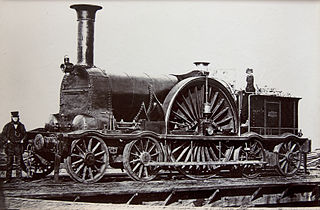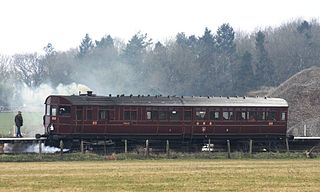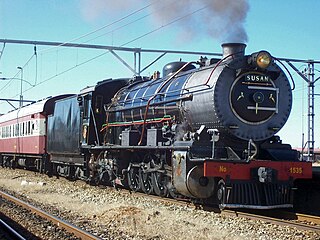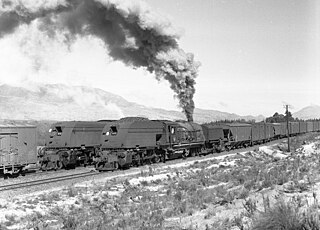
Under the Whyte notation for the classification of steam locomotives, 0-4-0 represents one of the simplest possible types, that with two axles and four coupled wheels, all of which are driven. The wheels on the earliest four-coupled locomotives were connected by a single gear wheel, but from 1825 the wheels were usually connected with coupling rods to form a single driven set.

Under the Whyte notation for the classification of steam locomotives, 4-2-0 represents the wheel arrangement of four leading wheels on two axles, two powered driving wheels on one axle and no trailing wheels. This type of locomotive is often called a Jervis type, the name of the original designer.

Under the Whyte notation for the classification of steam locomotives, 4-2-4 represents the wheel arrangement of four leading wheels on two axles, two powered driving wheels on one axle, and four trailing wheels on two axles.
Railmotor is a term used in the United Kingdom and elsewhere for a railway lightweight railcar, usually consisting of a railway carriage with a steam traction unit, or a diesel or petrol engine, integrated into it.

The steam rail motors (SRM) were self-propelled carriages operated by the Great Western Railway in England and Wales from 1903 to 1935. They incorporated a steam locomotive within the body of the carriage.
Under the Whyte notation for the classification of steam locomotives by wheel arrangement, a 4-8-2+2-8-4 is a Garratt articulated locomotive consisting of a pair of 4-8-2 engine units back to back, with the boiler and cab suspended between them. The 4-8-2 wheel arrangement has four leading wheels on two axles, usually in a leading bogie, eight powered and coupled driving wheels on four axles and two trailing wheels on one axle, usually in a trailing truck. Since the 4-8-2 type is generally known as a Mountain, the corresponding Garratt type is usually known as a Double Mountain.

Under the Whyte notation for the classification of steam locomotives by wheel arrangement, 2-6-2+2-6-2 is an articulated locomotive using a pair of 2-6-2 power units back to back, with the boiler and cab suspended between them. The 2-6-2 wheel arrangement has a single pair of leading wheels in a leading truck, followed by three coupled pairs of driving wheels and a pair of trailing wheels in a trailing truck.
The Lancashire and Yorkshire Railway (L&YR) operated two classes of twenty steam railmotors in total.

The South African Railways Class 18 2-10-2 of 1927 was a steam locomotive.

The South African Railways Class 16E 4-6-2 of 1935 is a class of passenger steam locomotive.

The South African Railways Class 12A 4-8-2 of 1919 was a steam locomotive.

The South African Railways Class 6Z 2-6-4 of 1901 was a steam locomotive from the pre-Union era in the Cape of Good Hope.

The South African Railways Class FC 2-6-2+2-6-2 of 1925 was an articulated steam locomotive.

The South African Railways Class GEA 4-8-2+2-8-4 of 1946 was an articulated steam locomotive.

A steam motor is a form of steam engine used for light locomotives and light self-propelled motor cars used on railways. The origins of steam motor cars for railways go back to at least the 1850s, if not earlier, as experimental economizations for railways or railroads with marginal budgets. These first examples, at least in North America, appear to have been fitted with light reciprocating engines, and either direct or geared drives, or geared-endless chain drives. Most incorporated a passenger carrying coach attached to the engine and its boiler. Boiler types varied in these earlier examples, with vertical boilers dominant in the first decade and then with very small diameter horizontal boilers. Other examples of steam motor cars incorporated an express-baggage or luggage type car body, with coupling apparatus provided to allow the steam motor car to draw a light passenger coach.

A steam railcar is a rail vehicle that does not require a locomotive as it contains its own steam engine. The first steam railcar was an experimental unit designed and built in 1847 by James Samuel and William Bridges Adams. In 1848, they made the Fairfield steam carriage that they sold to the Bristol and Exeter Railway, who used it for two years on a branch line.

The NZASM 19 Tonner 0-4-2T of 1891 was a South African steam locomotive from the pre-Union era in Transvaal.

The CSAR Railmotor of 1907 was a South African steam railmotor locomotive from the pre-Union era in Transvaal Colony.

The Cape Government Railways Railmotor of 1906 was a South African steam railmotor locomotive from the pre-Union era in the Cape of Good Hope.

Under the Whyte notation for the classification of steam locomotives, 0-4-0+4 represents the wheel arrangement of no leading wheels, four powered and coupled driving wheels on two axles and four trailing wheels on two axles mounted in a bogie.

















